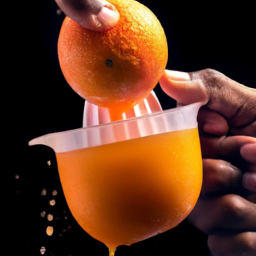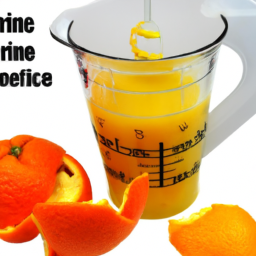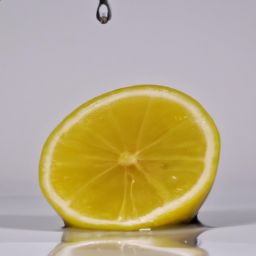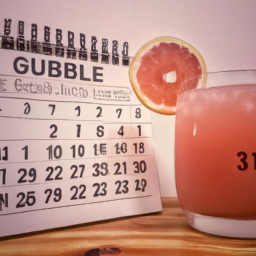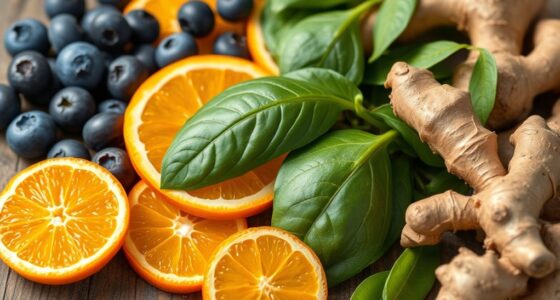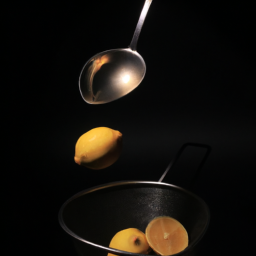As someone who loves fresh orange juice, I often think about how much juice can be squeezed from one orange. Surprisingly, the amount of juice you get can vary depending on different factors. In this article, I will explore these variables and provide tips on getting the most juice out of your oranges.
When it comes to juicing oranges, there are a few key things to keep in mind. First, the type of orange you choose can affect how much juice you get. Second, the way you prepare the oranges for juicing and the method you use to extract the juice can also impact the yield.
By understanding these factors and making some adjustments to your juicing process, you can maximize the amount of juice you get from each orange and enjoy a refreshing glass of citrus goodness.
Key Takeaways
- Orange juice yield is affected by factors such as variety, maturity, storage temperature, and juicing techniques.
- Valencia oranges are ideal for juicing due to their high juice content and well-balanced sweet-tart flavor.
- Preparation involves cleaning the oranges thoroughly, hand-squeezing or using an electric juicer, and straining the juice for a smooth consistency.
- Orange juice is a nutritious beverage rich in vitamin C and antioxidants, and can be stored in the refrigerator for up to 3 days or frozen for up to 6 months.
Factors Affecting Orange Juice Yield
You won’t believe how many factors can affect the yield of juice from an orange! Factors determining citrus juice yield include the variety of orange, the maturity of the fruit, the temperature at which it is stored, and juicing techniques used.
The impact of juicing techniques on orange juice extraction cannot be understated. Hand-squeezing an orange will yield less juice than using a citrus juicer. Moreover, factors such as the pressure applied during juicing and the temperature of the fruit can affect the amount of juice extracted.
To maximize juice yield, it’s important to use the right technique and equipment for the job. With that said, choosing the right oranges is equally important in obtaining maximum juice yield.
Choosing the Right Oranges
Selecting the right oranges is like finding a needle in a haystack – overwhelming but rewarding once you get the perfect one. When it comes to choosing oranges for juicing, there are several factors to consider, such as orange varieties and ripeness levels.
Different orange varieties have different flavors, textures, and juiciness. For instance, Valencia oranges are the most commonly used oranges for juicing because they have a high juice content and a balanced sweet-tart flavor. On the other hand, navel oranges are sweeter but have less juice than Valencia oranges. Blood oranges have a deep red color and a unique flavor but may not yield as much juice as other oranges.
Apart from the orange variety, the ripeness level also affects the juice yield. Oranges that are too ripe or overripe may have a softer texture and be more difficult to juice. On the other hand, oranges that are not ripe enough may not yield as much juice and may have a sour taste. Therefore, it’s recommended to choose oranges that are firm, heavy for their size, and have a smooth skin with no blemishes or soft spots.
By selecting the right oranges, you can maximize the juice yield and enhance the flavor of your juice.
When it comes to preparing oranges for juicing, there are several steps to follow to ensure optimal juice extraction.
Preparing Oranges for Juicing
To ensure your freshly squeezed orange juice is of the highest quality, it’s important to properly prepare the fruit before juicing.
First, make sure to thoroughly clean the oranges before use. This can be done by rinsing them under cool water and scrubbing them gently with a vegetable brush. This will remove any dirt or pesticides that may be on the surface of the fruit, ensuring that your juice is safe to consume.
If you don’t have a juicer, you can still make fresh orange juice by hand-squeezing the oranges. To do this, roll the oranges on a hard surface to loosen the juice inside. Cut the oranges in half and use a citrus reamer or juicer to extract the juice. Alternatively, you can use a fork to pierce the flesh of the orange and twist it to release the juice.
With these techniques, you can be sure that your orange juice will be fresh and delicious.
Hand-Squeezing Oranges
When it comes to getting the most out of your oranges, there’s nothing quite like hand-squeezing them. Not only does this age-old method produce a satisfyingly fresh and flavorful glass of juice, but it also comes with a range of benefits. For one, hand-squeezing oranges allows you to extract the maximum amount of juice possible, as you can feel the fruit and apply the right amount of pressure to get every last drop. Additionally, hand-squeezing oranges is a great way to get a little exercise and work out your arm muscles.
To get the most out of your hand-squeezed orange juice, there are a few techniques you should keep in mind. First, be sure to roll the oranges on a hard surface before slicing them in half, as this helps to break up the internal membranes and release more juice. When squeezing the oranges, use a gentle twisting motion to extract the juice without damaging the bitter white pith. And finally, be sure to strain your juice after squeezing to remove any pulp or seeds that may have made their way into the glass.
When it comes to making fresh orange juice, hand-squeezing is just one of the methods you can use. In the next section, we’ll take a look at using an electric juicer to streamline the process even further.
Using an Electric Juicer
If you’re looking for a faster and more efficient way to make fresh citrus juice at home, you might consider investing in an electric juicer. These machines are designed to extract the maximum amount of juice from your oranges with minimal effort. However, it’s important to take proper care of your juicer to ensure that it lasts as long as possible.
One of the most important aspects of electric juicer maintenance is cleaning. After each use, dismantle the juicer and rinse all of the parts in warm water. Use a gentle brush to remove any pulp or seeds that may have become lodged in the machine. Make sure that all parts are completely dry before reassembling the juicer. Additionally, if you encounter any issues with your electric juicer, such as a clogged filter or a malfunctioning motor, consult the user manual or contact the manufacturer for troubleshooting advice.
Transitioning to the subsequent section about straining and storing orange juice, it’s important to note that after you’ve extracted the juice, you’ll need to strain it to remove any pulp and seeds.
Straining and Storing Orange Juice
Now that you’ve extracted your fresh citrus juice, it’s time to strain it to ensure a smooth consistency and remove any unwanted bits. Straining is a crucial step in making orange juice, as it ensures your juice is free of pulp and seeds.
There are various methods of straining, but I prefer to use a fine-mesh strainer or cheesecloth.
Here are some juice storage methods and benefits of drinking orange juice that you should keep in mind:
-
Juice storage methods:
-
Store freshly squeezed orange juice in an airtight container in the refrigerator for up to 3 days.
-
Freeze the juice in ice cube trays and store them in a freezer-safe bag for up to 6 months.
-
If you plan to drink the juice immediately, add some ice cubes to it to keep it chilled.
-
Benefits of drinking orange juice:
-
Orange juice is a rich source of vitamin C, which is essential for a healthy immune system.
-
It contains antioxidants that help to protect your cells from damage caused by free radicals.
-
Drinking orange juice may help to lower your blood pressure and reduce the risk of heart disease.
Straining your orange juice is an important step that ensures a smooth and consistent texture. By using a fine-mesh strainer or cheesecloth, you can easily remove pulp and seeds.
Additionally, it’s important to keep in mind the various juice storage methods and benefits of drinking orange juice, so you can properly store your juice and reap the health benefits.
Now, let’s move on to calculating orange juice yield.
Calculating Orange Juice Yield
To figure out how much liquid you’ve extracted from your citrus fruit, it’s time to crunch the numbers and calculate your yield, so you can see the fruits of your labor. Start by measuring the amount of whole oranges you have before extracting the juice. This will give you a baseline for the amount of juice you can expect to yield.
Next, extract the juice from your oranges using your preferred method, whether it’s a hand-held juicer, electric juicer, or manually squeezing the fruit. Once you have extracted all the juice, measure the amount of liquid you have collected. Subtract any pulp or seeds that may have made their way into the juice.
This final measurement is your yield, or the amount of orange juice you were able to extract. Knowing your yield allows you to plan accordingly when using orange juice in recipes and ensures you get the most out of your citrus fruits.
As you now know how much juice you’ve extracted from your oranges, it’s time to explore the different ways you can use your freshly squeezed juice in recipes. From baking to cooking to making refreshing drinks, orange juice is a versatile ingredient that can add a burst of flavor to any dish.
Using Orange Juice in Recipes
Utilizing freshly squeezed citrus juice in culinary creations can provide a burst of tangy flavor to a variety of dishes. Orange juice, in particular, can be a versatile ingredient that can be used in sweet and savory recipes alike.
Here are some ways I like to use orange juice in my cooking:
- Incorporating orange juice into baking recipes like muffins, cakes, and bread can add a subtle sweetness and citrusy aroma to the dish.
- Using orange juice as a marinade for meat can help tenderize the meat and infuse it with a bright and zesty flavor.
- Adding a splash of orange juice to cocktails can create a refreshing and fruity twist to classic drinks like margaritas and mimosas.
- Mixing orange juice into salad dressings can provide a tangy and acidic element that complements the other ingredients in the salad.
In addition to its culinary uses, oranges can also have other practical uses around the house.
Other Uses for Oranges
I’ve found that oranges aren’t just great for their juice, but also for their peel. Zesting and grating oranges can add a burst of citrus flavor to many recipes. Plus, using the orange peel in recipes can provide a unique texture and added nutritional benefits.
So, don’t just throw away those peels! They can be used to make candies, syrups, and even cleaning solutions. And if you’re feeling adventurous, you can try using the whole orange in recipes like marmalade or orange chicken.
Overall, oranges are a versatile fruit that can be used in many different ways beyond just eating them as a snack.
Zesting and Grating Oranges
You’ll be amazed at how much flavor you can extract from an orange simply by zesting and grating it. Zesting techniques involve removing the colored outer layer of the orange peel, while grating methods involve shredding the entire peel.
Both methods release the essential oils of the orange, which contain the fruit’s unique flavor and scent. To zest an orange, use a zester or a grater with small holes. Hold the orange steady and gently rub the tool over the peel, making sure not to remove the white pith.
Grating an orange requires a larger grater and more pressure. Once the peel is shredded, you can use it in a variety of recipes, including baked goods, marinades, and dressings. Now let’s explore how to use orange peel in recipes.
Using Orange Peel in Recipes
Adding grated orange peel to your favorite recipes can give them a burst of citrus flavor that’ll make your taste buds sing.
Creative uses for orange peel include adding it to baked goods, smoothies, salads, and even savory dishes like roasted vegetables and marinades. The zest contains essential oils that’re responsible for the citrusy aroma and flavor. It’s important to only use the colored part of the peel and avoid the white pith, which has a bitter taste. To grate orange peel, use a microplane or a zester, and be careful not to grate too deeply.
In addition to its culinary uses, orange peel also has health benefits. It’s a good source of fiber, vitamin C, and antioxidants. The flavonoids in orange peel have anti-inflammatory and anti-cancer properties. However, be mindful of the amount of orange peel you consume, as it can also be high in pesticides. Choose organic oranges whenever possible, and wash the peel thoroughly before using.
With these tips in mind, adding grated orange peel to your recipes can not only enhance their flavor but also provide some health benefits.
When it comes to juicing oranges, there’re a few final tips for getting the most juice out of them.
Final Tips for Getting the Most Juice Out of Your Oranges
To maximize the amount of juice extracted from your oranges, gently roll them on a hard surface before slicing them open. This helps to break down the internal membranes, making the juice easier to extract. Additionally, be sure to use a sharp knife when cutting the orange to prevent crushing the fruit and losing valuable juice.
When selecting oranges for juice extraction, it’s important to consider the citrus variety. Navel oranges are known for their sweetness and are great for drinking, while Valencia oranges have a more tart flavor and are better for cooking and baking.
By choosing the right variety for your intended use, you can ensure that you get the most out of your oranges and create delicious dishes and drinks. Remember, every drop of juice counts!
Frequently Asked Questions
How many oranges are needed to make a glass of orange juice?
To produce a glass of orange juice, it depends on the type of juice being made. For fresh juice, it takes around 3-4 oranges. For concentrated juice, it may only take one orange due to the extraction process.
Can orange juice be frozen for later use?
Yes, orange juice can be frozen for later use. Freezing oranges before juicing can preserve freshness and flavor. Store juice in airtight containers, leaving some room for expansion, and thaw in the refrigerator.
Is the nutritional value of hand-squeezed orange juice different from that of electric juicer?
The nutritional value of hand-squeezed orange juice might differ from that of electric juicer due to the difference in the extraction method. However, further research is needed to determine the extent of the differences.
Can orange juice be used as a natural cleaning agent?
Using orange juice as a natural cleaning agent has its benefits. The citric acid in orange juice is effective in breaking down stains and grease. However, it may not be as effective as chemical cleaners for tougher stains.
How long can fresh orange juice be stored in the refrigerator?
I recently stored fresh orange juice in my refrigerator for up to 4 days before noticing changes in taste and color. Freshness indicators include a sour smell and darker color. Proper storage duration is up to 3-4 days.
Conclusion
In conclusion, maximizing the juice yield from an orange requires careful consideration of several factors. You need to choose the right oranges, prepare them properly, and use the right juicing method. It’s like solving a puzzle, where each piece needs to fit perfectly to create a beautiful picture.
Just as a puzzle requires patience, so too does juicing oranges. But the end result is worth it – a refreshing glass of freshly squeezed juice that can be used in a variety of delicious recipes. Remember that getting the most juice out of your oranges is not just about the quantity of juice but the quality as well.
The flavor and aroma of freshly squeezed orange juice are incomparable to store-bought juice. So take the time to choose the best oranges, prepare them properly, and use the right juicing method to maximize your yield. It’s like crafting a masterpiece – the attention to detail is what sets it apart from the rest.
So go ahead, put your juicing skills to the test, and enjoy the sweet fruits of your labor.
Ilana has been a vegan for over 10 years. She originally made the switch for health reasons, but soon found herself becoming more and more passionate about the ethical and environmental implications of a vegan lifestyle. Ilana is the author of The Graceful Kitchen, a blog all about veganism. She loves to cook up delicious and nutritious vegan meals, and share her recipes with others who are interested in leading a cruelty-free life. Ilana is also a strong advocate for using whole foods as the foundation of a healthy diet, and believes that going vegan is one of the best ways to achieve this.
